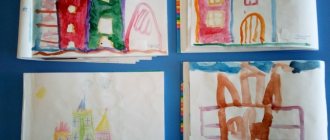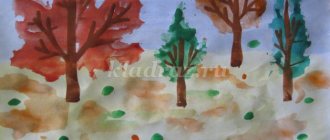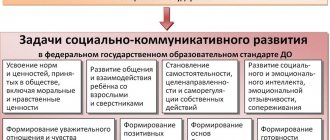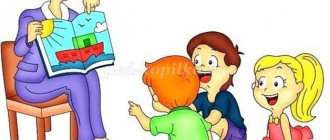What is family?
Summary of direct educational activities aimed at social and communicative development in the preparatory group
Goal
: to develop the concept of “Family” in children; supporting the development of warm relationships in the families of pupils, nurturing love and respect for family members.
Tasks
:
- to form children’s ideas about family and the diversity of families;
- develop the ability to answer questions;
- strengthen children’s design skills from waste materials;
- develop speech, attention, visual and auditory perception, logical thinking, creative abilities;
- to cultivate in children love and respect for family members, to show the value of family for every person.
Materials and equipment
: cardboard Dobra castle, boy doll, felt-tip pens, glue brushes, wet wipes, oilcloths, brush stands, PVA glue, cylinder blanks, doll parts; audio materials, video
Summary of a communication lesson for children in the preparatory group
Summary of a lesson on communication for children of senior preschool age
Summary of a communication lesson on the topic: retelling of the Russian folk tale “Fear has big eyes” (preparatory group).
Author: Elizarova Irina Stanislavovna, teacher, MB pre-school educational institution CRR DS “Zvezdochka”, Kondopoga Program content: 1. Introduce children to the content of a Russian folk tale. Bring to children’s understanding the double meaning of the fairy tale’s title: “Fear has big eyes.” To help understand the presence of humor in the actions of the characters. Continue learning to understand subject-schematic models based on the content of the work. To develop the ability to independently schematically convey the meaning of a proverb used in a fairy tale. 2. Continue teaching children to retell the content of a fairy tale coherently, consistently, expressively, emotionally and grammatically correctly (using models). Practice the formation of nouns with exaggeration suffixes (bear, wolf, cat). Improve the ability to express your thoughts on the topic proposed by the teacher. 3. Develop the ability to convey emotional states using facial expressions. Develop attention, memory, logical thinking. 4. To develop in children the ability to evaluate the retelling of a fairy tale by their peers. Preliminary work: talking with children about fear, drawing “My Fear,” drawing up schematic models for proverbs. Materials and equipment: book, schematic models, apple with the emotion “Fear”, sheets of paper and pencils (according to the number of children). Methodological techniques: verbal: questions to children, children’s answers, teacher’s generalization, artistic expression, reading a fairy tale with the conveyance of the emotional state of the characters, children’s retellings (in parts, in a chain), evaluation of the retelling, encouraging children;
visual: visual-schematic models for the content of a fairy tale; practical: exercise “Convey an emotion”, physical education lesson, drawing up a schematic model for a proverb. Progress of the lesson:
1. Children are asked to form a circle. “Guys, imagine that you are frowning like an autumn cloud (eyebrows knitted, eyes from under your forehead). - And now you are a person who is angry, how can you portray it? (displeased face). - Now smile like the sun smiles (there is a smile on your face) - Show how scared the hare is when he sees a wolf. You opened your eyes wide, some opened your mouth. Exactly, it’s clear that the hare was scared. - Guys, what is fear? (children’s answers and generalization of answers: fear is when someone is afraid of something). - What can you be afraid of? (children's answers: darkness, a stranger, thunder, a fairy-tale creature, etc.). - Guys, how can you get rid of fear? (children's answers). - And you and I know the “drive away”, with the help of which you can drive away fear. “Fear, horror, horror story. Rush, scurry, scurry! Turn into laughter, laughter, laughter! (performed with movements, 2 times) - Guys, have you ever had such cases when you were afraid of something that you could not have been afraid of, which in fact did not happen? (children's hypothetical answers). — I want to introduce you to a fairy tale where exactly such a story happened to the main characters, where they were afraid of something they shouldn’t be afraid of (children are invited to go to the tables). 2. Listen carefully so you can answer the questions later. Russian folk tale “Fear has big eyes” (reading a fairy tale). 3. Conversation on the content of the fairy tale. Questions: - What is the name of this fairy tale? (children's answers). - What are the names of the grandmother, granddaughter, chicken and mouse in the fairy tale? (children’s answers - water carriers). - Why do you think they are named like that? What two words did this word come from? (children's answers: carry water). - What kind of buckets did the water carriers have? (children's answers) - the teacher sets up models and uses his voice to highlight: the grandmother's - large (in a deep voice), the granddaughter's - smaller (in a normal voice), the chicken's - even smaller (in a thin voice), with which the buckets were compared: the chicken's - with a cucumber; the mouse’s is small, tiny (squeak) the size of a thimble. -Where did our water carriers get their water from? (children's answers: grandmother from a well; granddaughter from a log (a log is a thick log, the middle of which is hollowed out and filled with water; a chicken from a puddle; a mouse from a pig's hoof) - the teacher points to the models. - When they carried the water, how did it splash? (children's answers: for the grandmother - three-e-x, ple-e-h; for the granddaughter - three, plekh; for the chicken - three-three, plekh-plekh; for the mouse - three-three-three, plekh-plekh- plekh) - the teacher shows on the models. - Who seemed to be the heroes of the fairy tale? (children's answers: to the grandmother - a bear, as she spoke about him with fear - a bear - show what kind of eyes they had; to the granddaughter - a terrible wolf, what can you call a big strong wolf - a wolf; a hen - a fox; a mouse - a cat, a cat, show the mouse; a hare - four hunters, and all with dogs) _ what really happened? (children’s answers and a generalization of the children’s answers: all the heroes of the fairy tale were scared, and they themselves even they didn’t know what it really was.) -Could it be that we get scared and our eyes become very big from fear? Yes, that happens too. Sometimes you get so scared that your eyes actually become big. - What words does the fairy tale end with? (children's answers: fear has big eyes: what is not there, they see). - How do you understand these words? (children's answers). - What do you guys think, could the heroes of the fairy tale, after what happened to them, laugh at themselves? (children’s answers and generalization of answers: Yes, they were scared, something they didn’t need to be afraid of. (convey the humor of the fairy tale to the children). 4. Physical education. “Let’s go softly, like fox cubs. And like a bear, a bear. And like a gray wolf, little wolf. And the little bunny is a coward. So the wolf curled up into a ball, Because he was chilled. The ray touched the bunny, The bunny stretched sweetly" (done with movements, 2-3 times) 5. Repeated reading with a focus on retelling (the teacher reads a fairy tale, using emotions). - Guys, when you retell the story, don’t forget to tell about the water-carriers. where they went, what buckets they had, where they got the water from, then how they got scared and where they ran, who imagined it, and how the fairy tale ended (the teacher displays the models - sequence of the content of the fairy tale). 7. Evaluation of retellings (based on questions from the teacher, if the children find it difficult) - What did you like best about the retelling and why? — Who managed to convey the feeling of fear? 8. What does a fairy tale teach us? (children's answers) The teacher invites the children to draw a schematic picture for the last phrase - the proverb: “Fear has big eyes - what they don’t see, they see” (children’s options are considered, the teacher can offer his own version). 9. Result: questions for children: -What fairy tale did we meet? — What helped you remember the fairy tale? — What did you like about the lesson? - Who thinks that he coped with the retelling of the fairy tale today? — What was difficult? The teacher gives a general assessment of the lesson. P.S. If anyone is interested in the summary, I can send you visual and schematic models of the content of the tale.
We recommend watching:
Notes on educational activities for children of the senior group Notes on literacy lessons in the preparatory group Notes on FEMP in the preparatory group. Numbers from 1-8. Solving the simplest problems Plan - outline of GCD in the preparatory group for school
Similar articles:
Summary of GCD in the preparatory group on the topic: Professions
Lesson notes for the preparatory group. My family
Lesson notes for the preparatory group. Primitive people
Lesson notes for the preparatory group. Tolerance
Lesson summary for kindergarten on the topic “Human Rights”. Preparatory group



